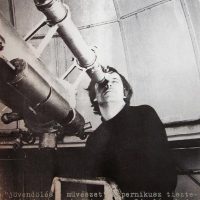The work fits into the series of Lakner entitled Self-Modelling; in these pieces the artist is visible in absurd situations while modelling social settings. In the work Parallaxis. Hommage a Kopernikusz Lakner circles around a lit light bulb, this way illustrating the movements of the Sun and the Earth; at the same time the claustrophobic space, the gesture of aimless circling refers to the situation of the artist, just like Moon Diary (1970), a playful and ironic piece in which Lakner documents his own walk on the Moon with quasi-scientific tools on a card file.
On the conceptual collage a photograph is visible made of the footprints left by the artist between Sárpentele and Úrhida, as the document of the fictitious walk, referring to the abyss between cosmic perspectives and Hungarian reality. The works refer to the space race of the Cold War era with a peculiar type of humour, and in this sense they can be contrasted with the works of Eastern European artists in which the “cosmic” theme appears (such as the works of the period by Július Koller and Stano Filko); still, primarily they can be interpreted in the context of Lakner’s oeuvre.
It is the first time that Lakner’s 1973 photography series is exhibited which shows the traces of the punches of Lakner’s fist on a pillow – the picturesque beauty of the photographs is re-interpreted by the series of actions referring to despair, tension, frustration, and helplessness. A similar situation is evoked by the label “Onanien” which appears on the fictitious, re-bound book of poetry of the artist.
An outstanding piece of the exhibition is Barricade (1972), a photorealistic painting by Lakner. This picture does not only evoke the 1968 Revolution (just like Lakner’s 1968 concept, Wounded Knife), but in general refers to revolutions as such. The painting portraying cobbles piled on each other which fill the whole painting and this way almost become a wall is the part of a larger series of painting.
The first piece of this series is a painting entitled Monument of Revolutions (1970), and is presently exhibited in the collection of the Essen Folkwang Museum. Lakner’s work belongs to the earliest conceptually-minded Hungarian cobblestone representations, however, it is still different from similar adaptations of the topic in the age: while connecting to the traditions of realistic painting, it refers to social questions which are up-to-date, and universal at the same time.
The conceptual works and paintings of Lakner created in the 70s are probably more topical now than at the time they were prepared: looking back from the 2010s we can state that Lakner’s “Prediction-Art” has been justified by time.
Dávid Fehér
